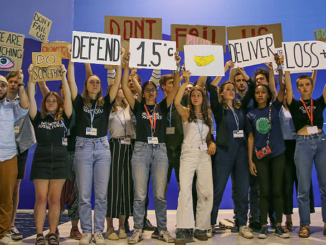
KAHULUI, Maui, Hawaii, December 9, 2021 (ENS) – An ambitious effort to rescue four tiny birds deep in a thick Hawaiian rainforest saw its first taste of success last weekend, giving hope for the survival of a critically endangered species driven to the brink of extinction by avian malaria: a consequence of climate change.
One six-month-old ’akikiki chick was safely rescued on Kauai and flown by helicopter to Maui for care. The chick and its family are believed to be among the last living ‘akikiki in what was once a safe haven for the critically endangered species.
A species of Hawaiian honeycreeper, ‘akikiki, Oreomystis bairdiare, are just a few inches long, and weigh less than half an ounce. They are found only in the wet, mountainous forest of the Alaka’i Wilderness Preserve on Kauai.
The rescue was part of an attempt to save the little honeycreepers, who live at the highest elevations of the forests, where they have been safe from mosquitos that carry avian malaria and other deadly diseases.
But as temperatures rise the mosquitos, too, have moved higher on the mountains; the tiny birds now have no escape.
Avian malaria now has nearly wiped out what was, until a decade ago, a healthy and breeding population of ‘akikiki in the area.
A team of six biologists has been camped in the forest for the last 10 days, looking for the bird, its fellow hatchling, and their parents, to place them into the care of the Maui Bird Conservation Center, managed by San Diego Zoo Wildlife Alliance.
The small team of experts from the Kauai Forest Bird Recovery Project, KFBRP; the Alliance; Pacific Bird Conservation; and the state Division of Forestry and Wildlife camped at the remote Halehaha research field camp, attempting to rescue the chick and its family. The team battled heavy rain and strong winds all week in their attempts to rescue the birds in mist nets strung across a high ridge, where the family had last been spotted. Last Saturday, they caught the chick in one of those nets, carried the bird down to camp, and fed and cared for it.
On December 5, a helicopter was dispatched from Maui to Kauai to pick up the bird, which was taken to the Maui Bird Conservation Center to join 42 other ‘akikiki. Most of these birds – all malaria-free – were hatched from wild-collected eggs.
In an ideal future, they would be joined by the other three members of the chick’s family that may be rescued in the future. While the chick is nicknamed Erica, its sex won’t be known until it matures in another six weeks.
Dr. Cali Crampton, who leads the KFBRP team, explained that this translocation project, approved at both federal and state levels, is an emergency attempt to keep this particular population of ‘akikiki from going extinct. A second population of the species lives a few miles away, but the total wild population in Kauai’s high-elevation forest is fewer than 50 birds.
While the newly rescued birds are at the Alliance’s facility, biologists will try to reclaim their native forest home, peossibly using a bacterium to act as mosquito birth control.
“Landscape-scale control of the mosquitoes that carry the disease killing these birds is still several years away,” Dr. Crampton said. “We estimate the ‘akikiki population only has two years left before malaria kills them all.”
A collaborative effort is underway to release sterile mosquitoes into the forest to cut total mosquito numbers, but it could be too little, too late to save the ‘akikiki and other native forest birds on Kauai. This is the motive for trying to move the Halehaha population into safety, while hoping the birds can be returned to their native habitat in the future.
In addition to the family of four, the scientists believe there might be one more ‘akikiki still alive at Halehaha.
San Diego Zoo Wildlife Alliance veterinarian Dr. Deena Brenner called the rescued chick, “a fit, healthy bird.”
For 30 days, the ‘akikiki chick will be isolated in a quarantine facility and will be getting anti-malarial medication in its food. “We think it’s possible this bird has been exposed to malaria out in the forest,” Dr. Brenner said. “In times of stress and change, birds may be more susceptible to getting sick.”
Dr. Brenner reflected, “This is very meaningful for me to contribute to this avian conservation effort, where I can directly apply my skills and experience working with birds in a zoo setting to positively impact the health of these critically endangered, very special birds. I’m extremely happy to help and care for this bird, and hopefully protect it to preserve the species.”
Featured image: Akikki on the Hohihi-Waiale Trail, Kauai, Hawaii, July 27, 2021 (Photo by Phil Chaon via e-Bird, Cornell Lab of Ornithology)
Environment News Service (ENS) © 2021 All Rights Reserved.



